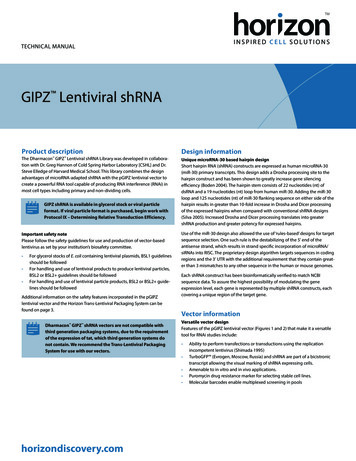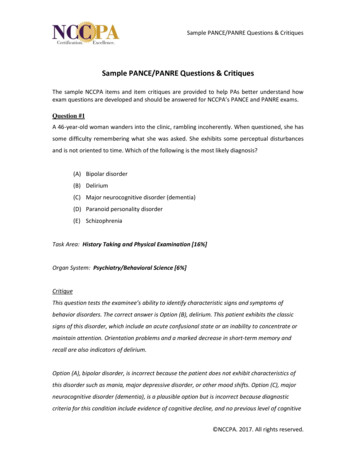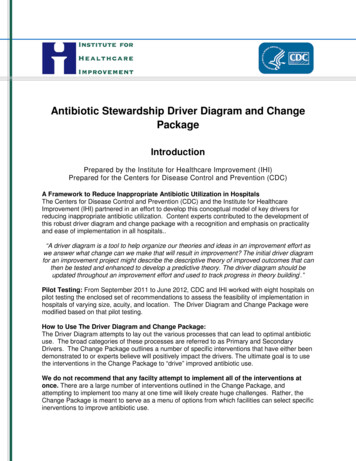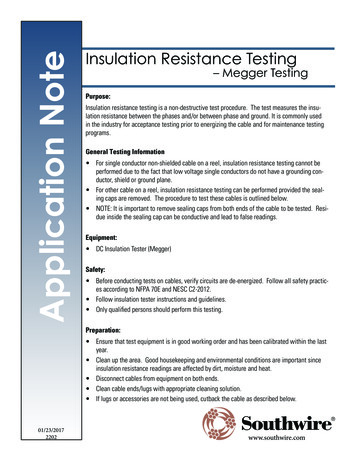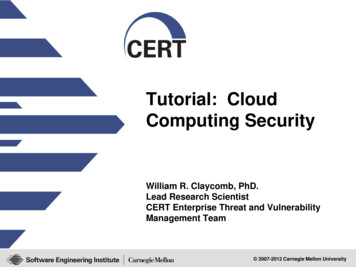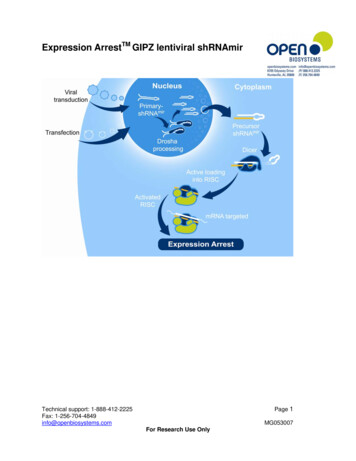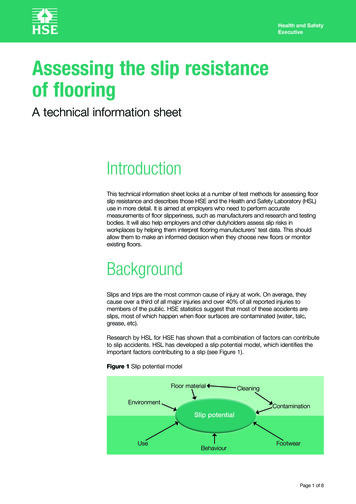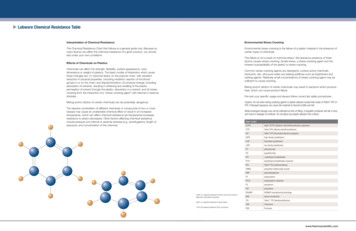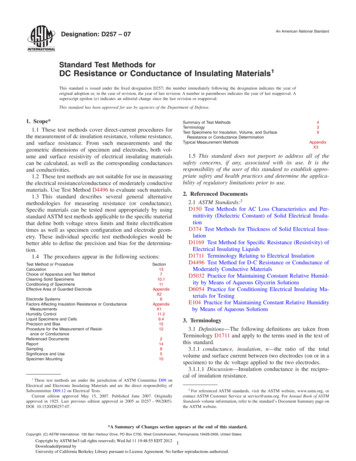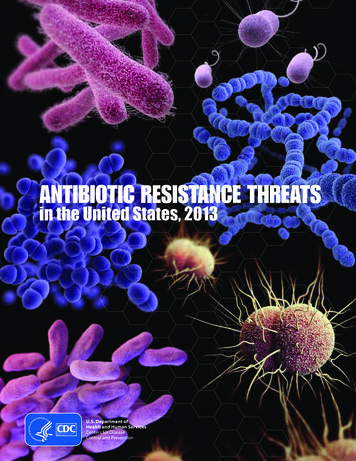
Transcription
ANTIBIOTIC RESISTANCE THREATSin the United States, 2013
TABLE OF CONTENTSForeword . . . . . . . . . . . . . . . . . . . . . . . . . . . . . . . . . . . . . . . . . . . . . . . . . . . . . . . . . . . . . . . . . . . . . . . . . . . . . . . . . . . . . . . . . . . . . . . 5Executive Summary. . . . . . . . . . . . . . . . . . . . . . . . . . . . . . . . . . . . . . . . . . . . . . . . . . . . . . . . . . . . . . . . . . . . . . . . . . . . . . . . . . . . . 6Section 1: The Threat of Antibiotic Resistance. . . . . . . . . . . . . . . . . . . . . . . . . . . . . . . . . . . . . . . . . . . . . . . . . . . . . . . . . 11Introduction. . . . . . . . . . . . . . . . . . . . . . . . . . . . . . . . . . . . . . . . . . . . . . . . . . . . . . . . . . . . . . . . . . . . . . . . . . . . . . . . . . . . . . . . . . 11National Summary Data. . . . . . . . . . . . . . . . . . . . . . . . . . . . . . . . . . . . . . . . . . . . . . . . . . . . . . . . . . . . . . . . . . . . . . . . . . . . . . . 13Cycle of Resistance Infographics. . . . . . . . . . . . . . . . . . . . . . . . . . . . . . . . . . . . . . . . . . . . . . . . . . . . . . . . . . . . . . . . . . . . . . . 14Minimum Estimates of Morbidity and Mortality from Antibiotic-Resistant Infections . . . . . . . . . . . . . . . . . . . . 15Limitations of Estimating the Burden of Disease Associated with Antibiotic-Resistant Bacteria. . . . . . . . . . . 18Assessment of Domestic Antibiotic-Resistant Threats . . . . . . . . . . . . . . . . . . . . . . . . . . . . . . . . . . . . . . . . . . . . . . . . . . 20Running Out of Drugs to Treat Serious Gram-Negative Infections. . . . . . . . . . . . . . . . . . . . . . . . . . . . . . . . . . . . . . . 22People at Especially High Risk. . . . . . . . . . . . . . . . . . . . . . . . . . . . . . . . . . . . . . . . . . . . . . . . . . . . . . . . . . . . . . . . . . . . . . . . . 24Antibiotic Safety. . . . . . . . . . . . . . . . . . . . . . . . . . . . . . . . . . . . . . . . . . . . . . . . . . . . . . . . . . . . . . . . . . . . . . . . . . . . . . . . . . . . . . 25Gaps in Knowledge of Antibiotic Resistance . . . . . . . . . . . . . . . . . . . . . . . . . . . . . . . . . . . . . . . . . . . . . . . . . . . . . . . . . . . 27Developing Resistance: Timeline of Key Antibiotic Resistance Events. . . . . . . . . . . . . . . . . . . . . . . . . . . . . . . . . . . .28Section 2: Fighting Back Against Antibiotic Resistance. . . . . . . . . . . . . . . . . . . . . . . . . . . . . . . . . . . . . . . . . . . . . . . . 31Four Core Actions to Prevent Antibiotic Resistance. . . . . . . . . . . . . . . . . . . . . . . . . . . . . . . . . . . . . . . . . . . . . . . . . . . . . 311. Preventing Infections, Preventing the Spread of Resistance . . . . . . . . . . . . . . . . . . . . . . . . . . . . . . . . . . . . . . . . 32CDC’s Work to Prevent Infections and Antibiotic Resistance in Healthcare Settings. . . . . . . . . . . . . . . . . . 32CDC’s Work to Prevent Antibiotic Resistance in the Community . . . . . . . . . . . . . . . . . . . . . . . . . . . . . . . . . . . . 34CDC’s Work to Prevent Antibiotic Resistance in Food . . . . . . . . . . . . . . . . . . . . . . . . . . . . . . . . . . . . . . . . . . . . . . 362. Tracking Resistance Patterns . . . . . . . . . . . . . . . . . . . . . . . . . . . . . . . . . . . . . . . . . . . . . . . . . . . . . . . . . . . . . . . . . . . . . .393. Antibiotic Stewardship: Improving Prescribing, Improving Use. . . . . . . . . . . . . . . . . . . . . . . . . . . . . . . . . . . . . 414. Developing New Antibiotics and Diagnostic Tests . . . . . . . . . . . . . . . . . . . . . . . . . . . . . . . . . . . . . . . . . . . . . . . . . 44Section 3: Current Antibiotic Resistance Threats in the United States, by Microorganism. . . . 49Microorganisms with a Threat Level of Urgent . . . . . . . . . . . . . . . . . . . . . . . . . . . . . . . . . . . . . . . . . . . . . . . . . . . . . . . . . 50Clostridium difficile. . . . . . . . . . . . . . . . . . . . . . . . . . . . . . . . . . . . . . . . . . . . . . . . . . . . . . . . . . . . . . . . . . . . . . . . . . . . . . . . . . 51Carbapenem-resistant Enterobacteriaceae . . . . . . . . . . . . . . . . . . . . . . . . . . . . . . . . . . . . . . . . . . . . . . . . . . . . . . . . . . 53Drug-resistant Neisseria gonorrhoeae. . . . . . . . . . . . . . . . . . . . . . . . . . . . . . . . . . . . . . . . . . . . . . . . . . . . . . . . . . . . . . . . 55Microorganisms with a Threat Level of Serious. . . . . . . . . . . . . . . . . . . . . . . . . . . . . . . . . . . . . . . . . . . . . . . . . . . . . . . . . 58Multidrug-resistant Acinetobacter . . . . . . . . . . . . . . . . . . . . . . . . . . . . . . . . . . . . . . . . . . . . . . . . . . . . . . . . . . . . . . . . . . . 59Drug-resistant Campylobacter. . . . . . . . . . . . . . . . . . . . . . . . . . . . . . . . . . . . . . . . . . . . . . . . . . . . . . . . . . . . . . . . . . . . . . . 61Fluconazole-resistant Candida (a fungus). . . . . . . . . . . . . . . . . . . . . . . . . . . . . . . . . . . . . . . . . . . . . . . . . . . . . . . . . . . . 63Extended spectrum β-lactamase producing Enterobacteriaceae (ESBLs). . . . . . . . . . . . . . . . . . . . . . . . . . . . . . 65Vancomycin-resistant Enterococcus (VRE). . . . . . . . . . . . . . . . . . . . . . . . . . . . . . . . . . . . . . . . . . . . . . . . . . . . . . . . . . . . 67Multidrug-resistant Pseudomonas aeruginosa. . . . . . . . . . . . . . . . . . . . . . . . . . . . . . . . . . . . . . . . . . . . . . . . . . . . . . . . 69Drug-resistant non-typhoidal Salmonella. . . . . . . . . . . . . . . . . . . . . . . . . . . . . . . . . . . . . . . . . . . . . . . . . . . . . . . . . . . . 71Drug-resistant Salmonella Typhi. . . . . . . . . . . . . . . . . . . . . . . . . . . . . . . . . . . . . . . . . . . . . . . . . . . . . . . . . . . . . . . . . . . . . 73Drug-resistant Shigella. . . . . . . . . . . . . . . . . . . . . . . . . . . . . . . . . . . . . . . . . . . . . . . . . . . . . . . . . . . . . . . . . . . . . . . . . . . . . . 75Methicillin-resistant Staphylococcus aureus (MRSA). . . . . . . . . . . . . . . . . . . . . . . . . . . . . . . . . . . . . . . . . . . . . . . . . . . 77Drug-resistant Streptococcus pneumoniae. . . . . . . . . . . . . . . . . . . . . . . . . . . . . . . . . . . . . . . . . . . . . . . . . . . . . . . . . . . . 79Drug-resistant tuberculosis . . . . . . . . . . . . . . . . . . . . . . . . . . . . . . . . . . . . . . . . . . . . . . . . . . . . . . . . . . . . . . . . . . . . . . . . . 81Microorganisms with a Threat Level of Concerning. . . . . . . . . . . . . . . . . . . . . . . . . . . . . . . . . . . . . . . . . . . . . . . . . . . . . 84Vancomycin-resistant Staphylococcus aureus (VRSA). . . . . . . . . . . . . . . . . . . . . . . . . . . . . . . . . . . . . . . . . . . . . . . . . . 85Erythromycin-resistant Group A Streptococcus. . . . . . . . . . . . . . . . . . . . . . . . . . . . . . . . . . . . . . . . . . . . . . . . . . . . . . . 87Clindamycin-resistant Group B Streptococcus . . . . . . . . . . . . . . . . . . . . . . . . . . . . . . . . . . . . . . . . . . . . . . . . . . . . . . . . 89Technical Appendix. . . . . . . . . . . . . . . . . . . . . . . . . . . . . . . . . . . . . . . . . . . . . . . . . . . . . . . . . . . . . . . . . . . . . . . . . . . . . . . . . . . . 93Glossary . . . . . . . . . . . . . . . . . . . . . . . . . . . . . . . . . . . . . . . . . . . . . . . . . . . . . . . . . . . . . . . . . . . . . . . . . . . . . . . . . . . . . . . . . . . . . . 107Acknowledgements . . . . . . . . . . . . . . . . . . . . . . . . . . . . . . . . . . . . . . . . . . . . . . . . . . . . . . . . . . . . . . . . . . . . . . . . . . . . . . . . . . 112
4ACINETOBACTER
FOREWORDAntimicrobial resistance is one of our most serious health threats. Infections from resistantbacteria are now too common, and some pathogens have even become resistant tomultiple types or classes of antibiotics (antimicrobials used to treat bacterial infections).The loss of effective antibiotics will undermine our ability to fight infectious diseasesand manage the infectious complications common in vulnerable patients undergoingchemotherapy for cancer, dialysis for renal failure, and surgery, especially organtransplantation, for which the ability to treat secondary infections is crucial.When first-line and then second-line antibiotic treatment options are limited by resistanceor are unavailable, healthcare providers are forced to use antibiotics that may be more toxicto the patient and frequently more expensive and less effective. Even when alternativetreatments exist, research has shown that patients with resistant infections are oftenmuch more likely to die, and survivors have significantly longer hospital stays, delayedrecuperation, and long-term disability. Efforts to prevent such threats build on thefoundation of proven public health strategies: immunization, infection control, protectingthe food supply, antibiotic stewardship, and reducing person-to-person spread throughscreening, treatment and education.Dr. Tom Frieden, MD, MPHDirector, U.S. Centers for Disease Control and PreventionMeeting the Challenges of Drug-Resistant Diseases in Developing CountriesCommittee on Foreign Affairs Subcommittee on Africa, Global Health, Human Rights,and International OrganizationsUnited States House of RepresentativesApril 23, 20135
ANTIBIOTIC RESISTANCE THREATS INTHE UNITED STATES, 2013Executive SummaryAntibiotic Resistance Threats in the United States, 2013 is a snapshot of the complex problemof antibiotic resistance today and the potentially catastrophic consequences of inaction.The overriding purpose of this report is to increase awareness of the threat that antibioticresistance poses and to encourage immediate action to address the threat. This documentcan serve as a reference for anyone looking for information about antibiotic resistance. It isspecifically designed to be accessible to many audiences. For more technical information,references and links are provided.This report covers bacteria causing severe human infections and the antibiotics used totreat those infections. In addition, Candida, a fungus that commonly causes serious illness,especially among hospital patients, is included because it, too, is showing increasingresistance to the drugs used for treatment. When discussing the pathogens included in thisreport, Candida will be included when referencing “bacteria” for simplicity. Also, infectionscaused by the bacteria Clostridium difficile (C. difficile) are also included in this report.Although C. difficile infections are not yet significantly resistant to the drugs used to treatthem, most are directly related to antibiotic use and thousands of Americans are affectedeach year.Drug resistance related to viruses such as HIV and influenza is not included, nor is drugresistance among parasites such as those that cause malaria. These are importantproblems but are beyond the scope of this report. The report consists of multiple one ortwo page summaries of cross-cutting and bacteria- specific antibiotic resistance topics.The first section provides context and an overview of antibiotic resistance in the UnitedStates. In addition to giving a national assessment of the most dangerous antibioticresistance threats, it summarizes what is known about the burden of illness, level ofconcern, and antibiotics left to defend against these infections. This first section alsoincludes some basic background information, such as fact sheets about antibiotic safetyand the harmful impact that resistance can have on high-risk groups, including those withchronic illnesses such as cancer.CDC estimates that in the United States, more than two million people are sickened everyyear with antibiotic-resistant infections, with at least 23,000 dying as a result. The estimatesare based on conservative assumptions and are likely minimum estimates. They are the bestapproximations that can be derived from currently available data.Regarding level of concern, CDC has — for the first time — prioritized bacteria in this reportinto one of three categories: urgent, serious, and concerning.6
Urgent Threats Clostridium difficile Carbapenem-resistant Enterobacteriaceae (CRE) Drug-resistant Neisseria gonorrhoeaeSerious Threats Multidrug-resistant Acinetobacter Drug-resistant Campylobacter Fluconazole-resistant Candida (a fungus) Extended spectrum β-lactamase producing Enterobacteriaceae (ESBLs) Vancomycin-resistant Enterococcus (VRE) Multidrug-resistant Pseudomonas aeruginosa Drug-resistant Non-typhoidal Salmonella Drug-resistant Salmonella Typhi Drug-resistant Shigella Methicillin-resistant Staphylococcus aureus (MRSA) Drug-resistant Streptococcus pneumoniae Drug-resistant tuberculosisConcerning Threats Vancomycin-resistant Staphylococcus aureus (VRSA) Erythromycin-resistant Group A Streptococcus Clindamycin-resistant Group B StreptococcusThe second section describes what can be done to combat this growing threat, includinginformation on current CDC initiatives. Four core actions that fight the spread of antibioticresistance are presented and explained, including 1) preventing infections from occurringand preventing resistant bacteria from spreading, 2) tracking resistant bacteria, 3)improving the use of antibiotics, and 4) promoting the development of new antibiotics andnew diagnostic tests for resistant bacteria.The third section provides summaries of each of the bacteria in this report. Thesesummaries can aid in discussions about each bacteria, how to manage infections, andimplications for public health. They also highlight the similarities and differences amongthe many different types of infections.This section also includes information about what groups such as states, communities,doctors, nurses, patients, and CDC can do to combat antibiotic resistance. Preventingthe spread of antibiotic resistance can only be achieved with widespread engagement,especially among leaders in clinical medicine, healthcare leadership, agriculture, and publichealth. Although some people are at greater risk than others, no one can completely avoid7
the risk of antibiotic-resistant infections. Only through concerted commitment and actionwill the nation ever be able to succeed in reducing this threat.A reference section provides technical information, a glossary, and additional resources.Any comments and suggestions that would improve the usefulness of future publicationsare appreciated and should be sent to Director, Division of Healthcare Quality Promotion,National Center for Emerging and Zoonotic Infectious Diseases, Centers for Disease Controland Prevention, 1600 Clifton Road, Mailstop A-07, Atlanta, Georgia, 30333. E-mail can alsobe used: hip@cdc.gov.8
9
10CAMPYLOBACTER
THE THREAT OFANTIBIOTIC RESISTANCEIntroductionAntibiotic resistance is a worldwide problem. New forms of antibiotic resistance cancross international boundaries and spread between continents with ease. Many forms ofresistance spread with remarkable speed. World health leaders have described antibioticresistant microorganisms as “nightmare bacteria” that “pose a catastrophic threat” to peoplein every country in the world.Each year in the United States, at least 2 million people acquire serious infections withbacteria that are resistant to one or more of the antibiotics designed to treat thoseinfections. At least 23,000 people die each year as a direct result of these antibiotic-resistantinfections. Many more die from other conditions that were complicated by an antibioticresistant infection.In addition, almost 250,000 people each year require hospital care for Clostridium difficile(C. difficile) infections. In most of these infections, the use of antibiotics was a majorcontributing factor leading to the illness. At least 14,000 people die each year in the UnitedStates from C. difficile infections. Many of these infections could have been prevented.Antibiotic-resistant infections add considerable and avoidable costs to the alreadyoverburdened U.S. healthcare system. In most cases, antibiotic-resistant infections requireprolonged and/or costlier treatments, extend hospital stays, necessitate additionaldoctor visits and healthcare use, and result in greater disability and death compared withinfections that are easily treatable with antibiotics. The total economic cost of antibioticresistance to the U.S. economy has been difficult to calculate. Estimates vary but haveranged as high as 20 billion in excess direct healthcare costs, with additional costs tosociety for lost productivity as high as 35 billion a year (2008 dollars).1The use of antibiotics is the single most important factor leading to antibiotic resistancearound the world. Antibiotics are among the most commonly prescribed drugs usedin human medicine. However, up to 50% of all the antibiotics prescribed for people arenot needed or are not optimally effective as prescribed. Antibiotics are also commonlyused in food animals to prevent, control, and treat disease, and to promote the growthof food-producing animals. The use of antibiotics for promoting growth is not necessary,and the practice should be phased out. Recent guidance from the U.S. Food and DrugAdministration (FDA) describes a pathway toward this goal.2 It is difficult to directlycompare the amount of drugs used in food animals with the amount used in humans, butthere is evidence that more antibiotics are used in food production.1 http://www.tufts.edu/med/apua/consumers/personal home 5 1451036133.pdf (accessed 8-5-2013); extrapolated fromRoberts RR, Hota B, Ahmad I, et al. Hospital and societal costs of antimicrobial-resistant infections in a Chicago teachinghospital: implications for antibiotic stewardship. Clin Infect Dis. 2009 Oct 15;49(8):1175-842 99624.pdf11
The other major factor in the growth of antibiotic resistance is spread of the resistant strainsof bacteria from person to person, or from the non-human sources in the environment,including food.There are four core actions that will help fight these deadly infections: preventing infections and preventing the spread of resistance tracking resistant bacteria improving the use of today’s antibiotics promoting the development of new antibiotics and developing new diagnostictests for resistant bacteriaBacteria will inevitably find ways of resisting the antibiotics we develop, which is whyaggressive action is needed now to keep new resistance from developing and to preventthe resistance that already exists from spreading.12
NATIONALSUMMARY DATAEstimated minimum number of illnesses anddeaths caused by antibiotic resistance*:At least2,049,44223,000illnesses,deaths*bacteria and fungus included in this reportEstimated minimum number of illnesses anddeath due to Clostridium difficile (C. difficile),a unique bacterial infection that, althoughnot significantly resistant to the drugs used totreat it, is directly related to antibiotic use andresistance:At least250,00014,000illnesses,deathsWHERE DO INFECTIONS HAPPEN?Antibiotic-resistant infections can happen anywhere. Data show thatmost happen in the general community; however, most deaths relatedto antibiotic resistance happen in healthcare settings, such as hospitalsand nursing homes.CS239559
How Antibiotic Resistance Happens1.Lots of germs.A few are drug resistant.2.Antibiotics killbacteria causing the illness,as well as good bacteriaprotecting the body frominfection.3.The drug-resistantbacteria are now allowed togrow and take over.4.Some bacteria givetheir drug-resistance toother bacteria, causingmore problems.Examples of How Antibiotic Resistance SpreadsGeorge getsantibiotics anddevelops resistantbacteria in his gut.Animals getantibiotics anddevelop resistantbacteria in their guts.Drug-resistantbacteria canremain on meatfrom animals.When not handledor cooked properly,the bacteria canspread to humans.Fertilizer or watercontaining animal fecesand drug-resistant bacteriais used on food crops.Vegetable FarmGeorge stays athome and in thegeneral community.Spreads resistantbacteria.George gets care at ahospital, nursing home orother inpatient care facility.Resistant germs spreaddirectly to other patients orindirectly on unclean handsof healthcare providers.Drug-resistant bacteriain the animal feces canremain on crops and beeaten. These bacteriacan remain in thehuman gut.Patientsgo home.Healthcare FacilityResistant bacteriaspread to otherpatients fromsurfaces within thehealthcare facility.Simply using antibiotics creates resistance. These drugs should only be used to treat infections.CS239559
15Infections Not IncludedAll infectionsHAIs with onset in hospitalizedpatientsAll infectionsHAIs with onset in hospitalizedpatientsHAIs caused by Klebsiella and E. coliwith onset in hospitalized patientsMultidrug-resistantAcinetobacter(three or more in iaceae(ESBLs)Infections caused by Enterobacteriaceae other than Klebsiella andE. coli (e.g., Enterobacter spp.)Infections acquired in acute care hospitals but not diagnosed untilafter dischargeInfections occurring outside of acute care hospitals (e.g., nursinghomes)Infections acquired in acute care hospitals but not diagnosed untilafter dischargeInfections occurring outside of acute care hospitals (e.g., nursinghomes)Not applicableInfections acquired in acute care hospitals but not diagnosed untilafter dischargeInfections occurring outside of acute care hospitals (e.g., nursinghomes)Not applicableInfections caused by Enterobacteriaceae other than Klebsiella andE. coli (e.g., Enterobacter spp.)Healthcare-associated InfectionsInfections occurring outside of acute care hospitals (e.g., nursing(HAIs) caused by Klebsiella and E. coli homes)with onset in hospitalized patientsInfections acquired in acute care hospitals but not diagnosed untilafter dischargeInfections Includedin Case/Death EstimatesDrug-resistantNeisseriagonorrhoeae )AntibioticResistantMicroorganismMinimum Estimates of Morbidity and Mortality from Antibiotic-Resistant matedAnnual Numberof Cases1,70022028500 5610EstimatedAnnual Numberof Deaths
16All infectionsInvasive infectionsAll infectionsDrug-resistantShigella(azithromycin saureus (MRSA)Streptococcuspneumoniae (fullresistance toclinically relevantdrugs)Not applicableBoth healthcare and community-associated non-invasive infectionssuch as wound and skin and soft tissue infectionsNot applicableNot applicableAll infectionsDrug-resistantSalmonella Typhi(ciprofloxacin†)Infections acquired in acute care hospitals but not diagnosed untilafter dischargeInfections occurring outside of acute care hospitals (e.g., nursinghomes)Not applicableHAIs with onset in aeruginosa (three ormore drug classes)Infections acquired in acute care hospitals but not diagnosed untilafter dischargeInfections occurring outside of acute care hospitals (e.g., nursinghomes)Infections Not IncludedDrug-resistant non- All infectionstyphoidal Salmonella(ceftriaxone,ciprofloxacin†, or5 or more drugclasses)HAIs with onset in hospitalizedpatientsInfections Includedin Case/Death EstimatesVancomycinresistantEnterococcus 0027,0003,800100,0006,70020,000EstimatedAnnual Numberof Cases7,00011,000 5 5404401,300EstimatedAnnual Numberof Deaths
17†Resistance or partial resistance*See technical appendix for discussion of estimation methods.Infections acquired in acute care hospitals but not diagnosed untilafter dischargeInfections occurring outside of acute care hospitals (e.g., nursinghomes, community)Non-invasive infections and asymptomatic intrapartum colonizationrequiring prophylaxis7,6001,300250,000Healthcare-associated infections inacute care hospitals or in patientsrequiring hospitalizationInvasive infectionsClindamycinresistant Group BStreptococcusNon-invasive infections including common upper-respiratoryinfections like strep throat 5Clostridium difficileInfectionsInvasive infectionsErythromycinresistant Group AStreptococcusNot applicable1,0422,049,442All infectionsVancomycinresistantStaphylococcusaureus (VRSA)Not applicableInfections Not IncludedEstimatedAnnual Numberof CasesSummary Totals forAntibiotic-ResistantInfectionsAll infectionsInfections Includedin Case/Death EstimatesDrug-resistanttuberculosis (anyclinically 023,488440160 550EstimatedAnnual Numberof Deaths
Limitations of Estimating the Burdenof Disease Associated with AntibioticResistant BacteriaThis report uses several methods, described in the technical appendix, to estimate thenumber of cases of disease caused by antibiotic-resistant bacteria and fungi and thenumber of deaths resulting from those cases of disease. The data presented in this reportare approximations, and totals, as provided in the national summary tables, can provideonly a rough estimate of the true burden of illness. Greater precision is not possible at thistime for a number of reasons: Precise criteria exist for determining the resistance of a particular species ofbacteria to a specific antibiotic. However, for many species of bacteria, there areno standard definitions that allow for neatly dividing most species into only twocategories—resistant vs. susceptible without regard to a specific antibiotic. Thisreport specifies how resistance is defined for each microorganism. There are very specific criteria and algorithms for the attribution of deaths tospecific causes that are used for reporting vital statistics data. In general, thereare no similar criteria for making clinical determinations of when someone’sdeath is primarily attributable to infection with antibiotic-resistant bacteria, asopposed to other co-existing illnesses that may have contributed to or causeddeath. Many studies attempting to determine attributable mortality rely onthe judgment of chart reviewers, as is the case for many surveillance systems.Thus, the distinction between an antibiotic-resistant infection leading directly todeath, an antibiotic-resistant infection contributing to a death, and an antibioticresistant infection related to, but not directly contributing to a death are usuallydetermined subjectively, especially in the preponderance of cases where patientsare hospitalized and have complicated clinical presentations.In addition, the estimates provided in this report represent an underestimate of the totalburden of bacterial resistant disease. 18The methodology employed in this report likely underestimates, at least forsome pathogens, the impact of antibiotic resistance on mortality. As describedin the technical appendix, the percentage of resistant isolates for some bacteriawas multiplied by the total number of cases or the number of deaths ascribedto that bacterium. A number of studies have shown that the risk of deathfollowing infect
Apr 23, 2013 · Antibiotic resistance is a worldwide problem . New forms of antibiotic resistance can cross international boundaries and spread between continents with ease . Many forms of resistance spread with remarkabl
